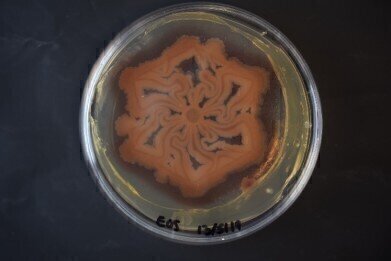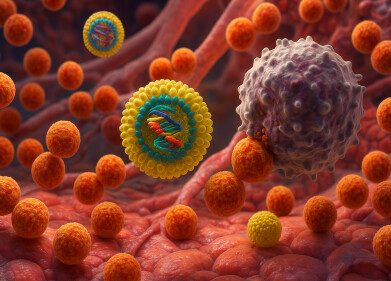-
 A bacterial biofilm patterned using MeniFluidics. Credit:University of Warwick
A bacterial biofilm patterned using MeniFluidics. Credit:University of Warwick
News
Science as Art – Engineering living Materials and Patterns
Jun 23 2020
Physicists and biologists at the University of Warwick have teamed up to develop a new method(1) for engineering living materials that could see a transformation in tissue engineering and bio-art, as well as new ways to research cellular interactions.
Living cells have many properties that non-living materials simply don’t. The ability of controlling the emergent behaviours of cells and organising them into arbitrary patterns is a key step forward towards utilising living materials, for uses such as organs on a chip. This is why new technologies are being developed to obtain such an ability.
Grounded on the physics of meniscus generation, the researchers applied the new technique called MeniFludics, to create structures into gel surfaces. Evaporation of water from gel materials lead to formation of open channels which can be used for guiding the direction and speed of cellular expansion.
Dr Vasily Kantsler, from Department of Physics at Warwick said; “I believe that our catchy named (Menifluidics) technique will enable new opportunities in biophysical and biomedical research and applications such as antibiotic resistance and biofouling”
Dr Munehiro Asally, from School of Life Science added: “We hope MeniFluidics will be used widely by biophysics, microbiologists, engineers and also artists! As it is a simple and versatile method.”
(1) Published in the journal ACS Synthetic Biology, titled 'Pattern engineering of living bacterial colonies using meniscus-driven fluidic channels'
Digital Edition
Lab Asia Dec 2025
December 2025
Chromatography Articles- Cutting-edge sample preparation tools help laboratories to stay ahead of the curveMass Spectrometry & Spectroscopy Articles- Unlocking the complexity of metabolomics: Pushi...
View all digital editions
Events
Jan 21 2026 Tokyo, Japan
Jan 28 2026 Tokyo, Japan
Jan 29 2026 New Delhi, India
Feb 07 2026 Boston, MA, USA
Asia Pharma Expo/Asia Lab Expo
Feb 12 2026 Dhaka, Bangladesh


















